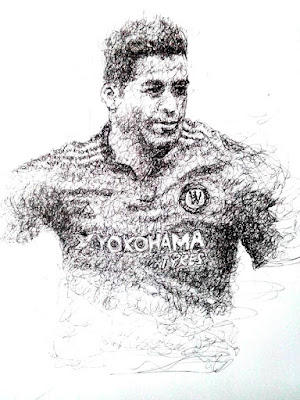Pencil Portrait Drawing Tips on Backgrounds
Backgrounds are useful to guide and enhance your vision of how you want to represent your subjects. Backgrounds can soften the presentation of your subject or make the presentation more energetic or dramatic.
However, whatever you do by way of backgrounds, always make sure that the background works with the subject and not against it. Also, do not forget that the subject is the reason you started the drawing in the first place. So, do not get caught up in your background to the point where it starts outshining your subject and diverts the attention of the viewer from your subject. So, usually, the background will be drawn with less detail and in a manner subordinate to the subject.
Here are a few tips on how to proceed with backgrounds so that they become a plus to the finished product instead of a negative:
* Contrasting Values - Take a clue from the values of your subject when choosing the value scheme for your background treatment. If your subject is very light on one side, it is always a good idea to make the background in that area darker. This will introduce the necessary contrast. The same is true for dark areas in your subject boundaries. If they are dark then make your background lighter.
It also solves the problem of white against white. For example, if your subject has white hair, it is always difficult to make it sufficiently show against the white background of your white paper. Introducing a darker background around the hair is the perfect solution. This, of course, also works in reverse. If your subject is dark in places, you may want to contrast this with a light background.
* Lost and Found Edges - The background treatment can also be used to produce so-called "lost and found edges". These are edges that initially show where there is significant contrast between bordering areas but then get lost where the values of the neighboring areas are the same. The lost edge finally reappears when the contrast between the bordering areas is again significant.
The disappearing act of the edge is accomplished by rendering the edge and the surroundings with the same value. For example, the edge of a sleeve could be partially lost in the background by giving the background the same value as that part of the sleeve. Lost and found effects are always interesting and involve the viewer in the process of completing the drawing. The eye automatically takes over the task of completing the edge and looking how to best accomplish this.
* Location in the Background - It is usually a good idea to keep the shading below the eye level of the subject you are drawing. Shading above the eye level tends to weigh down the subject and does not add to the crispness of the portrait.
* Extensive Background Drawing - Sometimes your client may insist on a detailed pictorial background. First, make sure you increase the fee, because you will often spend more time on your background drawing than on the subject itself.
Second, always be aware that the subject must remain the focal point of the finished product. So, develop the facility for judging what enhances the subject and what detracts from it. The background must invariably be secondary to the subject.
Ideally, a pictorial background should talk about your subject and give the viewer more information about your subject. A background is also very useful to create or enhance a mood. If your subject is portrayed in a certain mood, you may want to enhance that mood by adding a background that appropriately reflects the same mood.
About the Author
Remi Engels, Ph.D., is a pencil portrait artist and oil painter. Samples of Remi's work can be found at Remi's Pencil Portraits and Remi's Oil Paintings. You are also cordially invited to subscribe to his Free Portrait Drawing Course and his popular Art Tip Newsletter.

